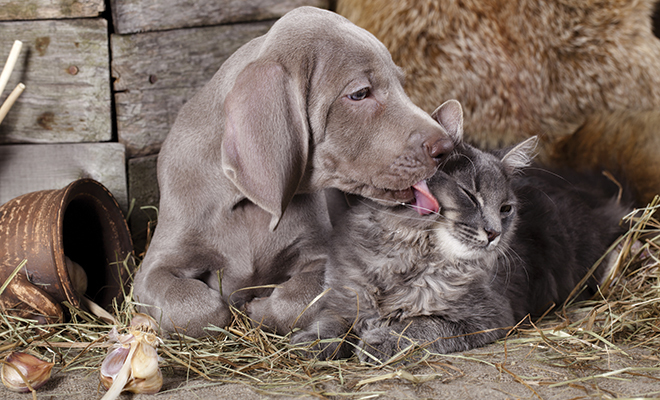
Keep your pets healthy and happy
According to the American Pet Products Association, nearly 100 million families share their homes with domesticated animals, including 55 million homes with dogs, 43 million with cats and another 50 million with unusual pets such as guinea pigs, rabbits, birds, fish and reptiles. Six of ten Americans own at least one pet.
In the last decade, the attitude toward pets has evolved as well. Most people–95.6 percent–now consider their pet to be a member of the family, up 10 percent from only 10 years ago. Then, Americans spent a mere $39 billion to care for their animals. Now, that amount has risen to $61 billion and includes food and vet care, toys, clothes and birthday gifts. People clearly love their animals.
So what can pet owners–um, sorry–pet parents do to make sure their animal companion leads a healthy and happy life?
Feed your pet high-quality food
Check the labels of commercial food to find the healthiest mix available. For dogs, that means high levels of animal-based protein. Meat byproducts, which include organ meats such as hearts, livers, kidney and connective tissue, despite what many people think, are not only acceptable, but are highly nutritious. Look for kibble with high fiber from whole grains, vitamin-rich oils and essential vitamins and minerals. To keep your dog trim, pay attention to portion control and keep treats to a minimum. Ask your veterinarian to recommend a food if your pet requires a special diet.
Cats are strict carnivores and require a very different diet than dogs. Their food should have high amounts of digestible protein and fat. Cats do better eating canned food rather than dry food, which often has high levels of carbohydrates and the wrong type of proteins. If, for some reason, feeding dry kibble is the only option, supplement it with some canned food.
Schedule regular veterinarian visits
Pets, like people, need annual health exams. A veterinarian will check your pet’s heart, lungs, ears, teeth, eyes and skin to make sure there are no outstanding health problems. They may recommend ways to prevent parasites that can carry or cause serious diseases and a vaccination protocol. For dogs beyond the puppy stage, recommended vaccines can include protection from rabies, canine influenza and kennel cough. For cats, this means vaccines against rabies, feline distemper and feline herpes viruses. And don’t forget small pets. They need vet checks, too.
Everybody needs exercise
Dogs need regular exercise, and most dogs will jump at the chance. Depending on the size, age and breed of dog, a walk around the block twice a day may be enough. Other dogs need much more, from a romp in the park to a run with their owner or an afternoon of chasing a Frisbee. Some cats require more incentive to work out. Many cats love the laser pointer game. Move your cat’s food from the floor to the counter and back, making a game out of jumping. Cat toys, cat trees and scratching posts encourage movement, too. Cats need only a total of about 10 to 20 minutes a day of activity, so there’s very little excuse for the owner to have an unfit cat.
Spay or neuter your pet
Beyond the social advantages of preventing unwanted litters, spaying and neutering has direct health advantages, including the chance of a longer and healthier life. Early spaying of female dogs and cats can protect them from breast cancer and uterine cancer or infections. Neutering male dogs and cats lessens the risk of prostate problems and testicular cancer. There are behavioral advantages too, including removing the breeding instinct, male territory marking, the heat cycle and, in cats, the elimination of female yowling and the male inclination to roam.
Pay attention to dental health
According to the American Veterinary Dental Society, 80 percent of dogs and cats older than three years show signs of oral disease. Tooth and gum problems have been linked to loss of teeth and oral cancer as well as heart and kidney disease. Good dental health can lengthen the life of a dog or cat up to five years. Bad breath in pets is not normal and may be indicative of a serious problem. Vets recommend giving dogs edible dental chews or hard chew toys to help reduce tartar. Cats, too, can chew on hard, raw or slightly cooked bones (no pork, chicken or fish bones). You can also brush your dog’s or cat’s teeth; toothpaste comes in flavors such as chicken to make cleaning easier. If you can’t find a way to clean your pet’s teeth, a vet can do it for you.
One more thing: invest in a microchip
Even the most closely watched dogs or cats can escape from a secure home or yard. Lost pets can end up, at best, adopted by someone else and at worst at a high-kill facility. A microchip will let everyone know that you are waiting, ready to bring your four-legged family member home. HLM
Sources: aspca.org, petfoodindustry.com, petinsurance.com, petmd.com and theharrispoll.com.







